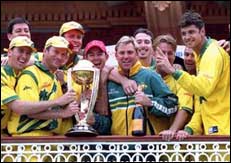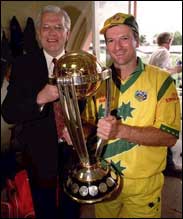Perspective needed in World Cup quest
Daniel Laidlaw
With the one-day World Cup now the primary focus and most coveted trophy of every cricket nation, and the preparation for the event seemingly beginning
as the soon as the previous one ends, loss of form by teams or players in
the largely inconsequential lead-up matches and tournaments is now being
greeted with increasing hysteria.
The eighth World Cup in southern Africa is still a year away, a long time in
any sport, but the likes of England, Australia, India, Sri Lanka, South
Africa and others have had it in mind for some time already. For all but one
team, years of planning is going to end in despair and crushing
disappointment, and for an example of how seriously an immaculate
preparation is being taken you need only look at the reaction to champions
Australia's three successive defeats to start the annual tri-series Down Under last week.
A few weeks after Australia destroyed South Africa in the Test series 3-0,
and three ODI defeats later, it was suddenly realised that Steve Waugh can't
captain, his brother can't bat, the rotation policy Australia has utilised
for the last two years should be abandoned forthwith, the middle order needs
revamping and fresh blood is required. In short, Australia needed a complete
overhaul, with an eye to the World Cup on the horizon.
 Granted, change is almost always resisted, and the overhaul which set
Australia on the path to success at the last World Cup was also dramatic and
controversial. When the time comes to replace leaders and senior players
with new faces, it likely will not be with their full blessing. However,
while always bearing the future in mind, it is still important not to
mistake momentary poor form for a fundamental failure of philosophy and
personnel, which is what critics have done to some degree.
Granted, change is almost always resisted, and the overhaul which set
Australia on the path to success at the last World Cup was also dramatic and
controversial. When the time comes to replace leaders and senior players
with new faces, it likely will not be with their full blessing. However,
while always bearing the future in mind, it is still important not to
mistake momentary poor form for a fundamental failure of philosophy and
personnel, which is what critics have done to some degree.
Before campaigning for a change to the structure of any team, it must be
carefully considered whether results are an indication of the future, or
merely show a lapse in the present. This requires a sense of perspective
that is in danger of becoming skewed by measuring success or failure by
World Cup campaigns.
This kind of over-reaction occurs in two ways. Firstly there is the loss of
focus on the big picture, as defeats which happen partially as a result of
experimentation for the Cup are ironically interpreted as an indication that
planning for the event has gone awry, causing undue calls for modification.
The second is that because of the unspoken emphasis placed on the tournament
itself, failure of a perfectly good team to win the trophy could cause
unwarranted upheaval at the expense of Test development. With distinctions
being made between the two forms of the game, that is less likely to happen
now, but the importance of progress at Test level in comparison to
performance at a quadrennial one-day tournament must be kept in perspective.
To return specifically to the recent Australian example, closer inspection
of the home team's precarious start to the one-day series revealed only a
team in need of fine-tuning, not a new engine. What was impossible to accept
was not the criticism of the mediocre performances but of the philosophy in
place.
Australia first instituted what has become known as the rotation policy two
seasons ago and it has always been viewed with some scepticism. It is just
one of the innovations of the Waugh/Buchanan leadership liaison, as they
seek to build a squad of players, rather than just an XI, who are equally
proficient and prepared to perform when required. This way, they maintain,
should Australia suffer any injuries before or during the World Cup, they
will not have to call upon reserve players who have neither the experience
nor confidence to immediately be effective replacements.
 This seems to be the reason why Waugh appears uncomfortable answering
questions about Australia's "best XI" in one-day cricket, as he clearly
intends to build a squad where there is no such thing. Whether it is called
rotation or maximising the abilities of the talent pool, it is not
dissimilar to a pitching rotation in American Major League baseball or the
resting of players by Europe's elite football clubs, and is quite obviously
a sign of progress. The policy should lead not only to a squad of better
players in the long-term but also prevent fatigue injuries.
This seems to be the reason why Waugh appears uncomfortable answering
questions about Australia's "best XI" in one-day cricket, as he clearly
intends to build a squad where there is no such thing. Whether it is called
rotation or maximising the abilities of the talent pool, it is not
dissimilar to a pitching rotation in American Major League baseball or the
resting of players by Europe's elite football clubs, and is quite obviously
a sign of progress. The policy should lead not only to a squad of better
players in the long-term but also prevent fatigue injuries.
On the flip side, the main concern with the rotation policy, and the one
which so irks its critics, is when Australia loses matches with a team not
seen to be its best XI, which has happened in New Zealand and India in the
last two years. It is claimed, or at least should be if fully articulated,
that the benefits to be gained by playing reserve players for an occasional
match are outweighed by the detrimental affect of upsetting the balance of
the side and the form of the players themselves.
While valid, that argument is not the fault of the policy per se, but rather
the way it has been recently employed, which is where a clear distinction
needs to be made. The interchange of batsmen in Australia's first four
matches was not managed smoothly enough to ensure the players concerned
actually benefited.
Matthew Hayden hardly had a stable environment in which to prove himself
when selected for his team's second and fourth matches without knowing
whether he would be picked for the next. Ian Harvey played two of the first
three games before making way for Andrew Symonds, while Damien Martyn moved
up from six to four.
In Australia's three losses, its batting was largely responsible, scores of
176, 198 and 212 not helped by the alternating line-ups. Improvement was
already underway in making 241 in game four against South Africa, before
blitzing the Proteas again with a first-choice team.
After dropping Hayden from the squad and selecting the best batsmen for the
last game, it has been dubiously claimed that the Aussie selectors have
abandoned the rotation policy. Rather, they have returned to implementing it
prudently, with batsmen first given a chance to establish form before being
substituted. The bowlers will still be rested when required.
If anything, Australia hurt itself in the initial matches by being spoilt
for choice, unable to decide upon its immediate future due to multitude of
options and fielding an unsettled line-up as a consequence. The answer is
what has now been adopted, a judicious system of rotation whereby players
will spend more successive matches in the team before sitting out. That way,
there is an opportunity to build form without being concerned by the
possibility of being rotated out of the next match.
All that is left then is the minor matter of continuing to win matches. The
quality of the opposition has an oft-overlooked part to play in that regard,
but with a more consistent policy and the necessary improvement in form
achieved, Australia should again contest the cigarettes-and-beer finals. If
they do not, the World Cup is still 12 months away, with the right
perspective hopefully much nearer at hand.
More Columns
Mail Daniel Laidlaw